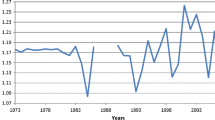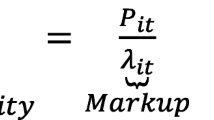Abstract
This paper applies a refined market power test to examine market power in the U.S. aluminum industry. The study conducts a two-step analysis in which the inverse residual demand facing the industry is first estimated to generate the associate elasticity to infer market power, and then the inverse partial residual demand facing the industry is estimated to produce the elasticity to measure the potential effect of inter-industry coordination. The results suggest that only the primary industry attains market power, and the market power can exert even without collusion between the primary and secondary industries.
Similar content being viewed by others
References
Adams, W. (1951) ‘The Aluminum Case: Legal Victory — Economic Defeat’, American Economic Review, 16, 915–922.
Aluminum Statistical Review (1954–1984) Washington: The Aluminum Association.
American Bureau of Metal Statistics Yearbook (1954–1984) Washington: American Bureau of Metal Statistics.
Baker, J. B., and T. F. Bresnahan (1985) ‘The Gains from Merger or Collusion in Product-Differentiated Industries’, The Journal of Industrial Economics, 33, 427–444.
Baker, J. B., and T. F. Bresnahan (1988) ‘Estimating the Residual Demand Curve Facing a Single Firm’, International Journal of Industrial Organization, 6, 283–300.
Bresnahan, T. F., and V. Y. Suslow (1989) ‘Short-Run Supply with Capacity Constraints’, The Journal of Law and Economics, 32, S11–S42.
Engle, R. F., and C. W. J. Granger (1987) ‘Co-integration and Error Correction Representation, Estimation, and Testing’, Econometrica, 55, 251–276.
Hausman, J. A. (1978) ‘Specification Tests in Econometrics’, Econometrica, 46, 1251–1271.
Industry Division, Economic Commission for Europe Steel Committee (1954) Competition between Steel and Aluminum. United Nation: Economic and Social Council.
International Primary Aluminum Institute, http:www.world-aluminum.org/main.html Landes, W. M., and R. A. Posner (1981) ‘Market Power in Antitrust Cases’, Harvard Law Review, 94, 937–996.
Metal Statistics (1954–1984) Washington: American Metal Market.
Metals Week (1969) Aluminum: Profile of an Industry. New York: McGraw-Hill, Inc.
Metals Week (1982) Aluminum: Profile of the Industry. New York: McGraw-Hill, Inc.
OECD (1983) Aluminum Industry: Energy Aspects of Structural Change. Paris: OECD Publications Office.
Salant, S. W., S. Switzer, and R. J. Reynolds (1983) ‘Losses from Horizontal Merger the Effects of an Exogenous Change in Industry Structure on Cournot—Nash Equilibrium’, Quarterly Journal of Economics, 98, 185–213.
Smith, G. D. (1988) From Monopoly to Competition: The Transformations of Alcoa, 1888–1986. Cambridge: Cambridge University Press.
Suslow, V. Y. (1986) ‘Estimating Monopoly Behavior with Competitive Recycling: An Application to Alcoa’, Rand Journal of Economics, 17, 389–403.
U.S. Bureau of the Census (1954–1984) Current Industrial Reports. Washington: Government Printing Office.
U.S. Bureau of the Census (1954–1984) Statistical Abstract of the United States. Washington: Government Printing Office.
U.S. Department of the Interior (1954–1984) Minerals Yearbook. Washington: Government Printing Office.
U.S. President Council of Economic Advisers (1954–1984) Economic Report of the President.Washington: Government Printing Office.
Yang, S. P. (1998) ‘Identifying andMeasuring Market Power with Residual Demand Elasticity: Evidence from the U.S. Aluminum Market, 1954–1984’, Unpublished Ph.D. Dissertation, University of Nebraska, Lincoln.
Author information
Authors and Affiliations
Rights and permissions
About this article
Cite this article
Yang, SP. Measuring Market Power in the U.S. Aluminum Industry: A Residual Demand Approach. Review of Industrial Organization 19, 365–380 (2001). https://doi.org/10.1023/A:1011820525065
Issue Date:
DOI: https://doi.org/10.1023/A:1011820525065




